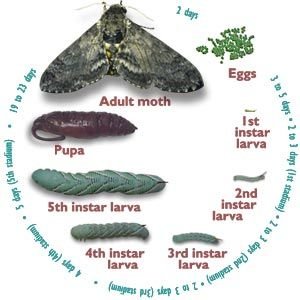
These green caterpillars are the larval stage of moths, and they pack quite a punch when it comes to the moth lifecycle. Imagine them as the awkward teenagers of the moth world—growing, eating, and eventually undergoing some serious changes. Let’s dive into how these hornworms contribute to the incredible journey from caterpillar to moth.
Understanding Hornworms: The Caterpillar Stage
Hornworms are the larval stage of several species of moths, most notably the tobacco hornworm (Manduca sexta) and the tomato hornworm (Manduca quinquemaculata). These caterpillars are known for their striking green color and a distinctive horn-like structure on their rear end, which gives them their name. You might be wondering why they look so different from the adult moths they grow up to be.
This stage is all about growth. These caterpillars can eat a massive amount, munching on leaves of plants like tomatoes and tobacco, which is why they are often seen as garden pests. Nevertheless, their ravenous appetite is crucial. As they eat, they gather energy and nutrients that will fuel their transformation into moths. It’s like a teenager loading up on snacks before an important exam—they need the energy for what’s coming next!
During this phase, hornworms grow quickly. In just a couple of weeks, they can increase their size substantially, sometimes consuming several leaves per day. You can often tell when they’re ready to undergo metamorphosis by their size and the presence of feeding damage on plants.
The Metamorphosis Process
Once the hornworm reaches its full size, it’s time for a big change. This is where the real magic of the lifecycle occurs. The hornworm will stop eating, and instinctively, it begins to look for a safe spot to pupate. This is when the caterpillar changes into a pupa, or chrysalis.
You might think of this as a caterpillar going into a “cocoon” for a nap, but the reality is much more complex. Inside this protective casing, the hornworm undergoes dramatic changes. Cells break down and reorganize, creating the structures needed for the mature moth. It’s almost like a complete rebranding—everything from the body shape to the color patterns is transformed.
This transformation can take anywhere from a few days to several weeks, depending on environmental conditions like temperature and humidity. Think of it as a suspenseful waiting game; the longer the pupation, the more curious you become about what’s about to emerge.
The Role of Pupation in the Lifecycle
During pupation, the hornworm effectively goes into a state of dormancy. Inside the chrysalis, it’s a frenzy of cellular activity. New tissues form, and the caterpillar’s old body is broken down, paving the way for the development of the adult moth. This stage is critical—not just for the hornworm itself but for the entire ecosystem.
Once the metamorphosis is complete, the adult moth is ready to emerge. The soft, delicate wings are initially crumpled and wet, requiring time to dry and expand. This is a vulnerable moment, as many predators are watching closely. You might think of this stage as the grand unveiling of a butterfly at an art show—there’s beauty, excitement, and the potential for danger all wrapped up in one moment.
Pupation does more than bring about a new moth; it’s an adaptation that allows these insects to survive through harsh conditions. If the weather turns cold or dry, the adult moth can wait, emerging only when conditions are right for mating and laying eggs. That’s a smart strategy for survival!
Adult Moths: The Next Chapter
When the adult moth finally breaks free, it’s not just a new start for the individual; it’s a continuation of the cycle. The adult moths have a brief lifespan, usually ranging from a few weeks to several months, depending on the species. Their main job? To find mates and lay eggs, continuing the cycle of life that began with the hornworm.
Adult moths are also responsible for pollination, which is often overlooked. While butterflies get a lot of attention for their pollination skills, many moth species play an equally important role at night. Imagine a busy nightlife where the moths are flitting from flower to flower, helping plants reproduce while you’re dreaming away.
Additionally, moths themselves become a food source for birds, bats, and other predators. They’re integral to the food web, showing just how interconnected life can be.
The Ecological Importance of Hornworms
Hornworms may seem like mere garden nuisances to many, but they actually serve a significant role in the ecosystem. By feeding on plants, they help to keep those plants in check. This is important for maintaining a balanced ecosystem. Too many plants can lead to overcrowding, which can harm other species—so hornworms are nature’s little helpers in keeping that balance.
Moreover, as they transform into adult moths, they contribute to biodiversity. Moths are an important food source for many other animals. In fact, some species of moths are vital for pest control, as their larvae can feed on other detrimental insects.
Here’s the thing: if we want healthy gardens and ecosystems, we need to understand and appreciate hornworms for the role they play in their lifecycle and beyond. They’re not just pests; they’re part of the team.
Final Thoughts: The Life Cycle Beyond Hornworms
So, there you have it—a glimpse into the stunning lifecycle of moths, starting from the humble hornworm. From caterpillar to pupa to moth, each stage is filled with purpose and beauty. Understanding this cycle can help us appreciate the balance of nature a little more.
When you see a hornworm munching on your garden plants, instead of reaching for that pesticide, consider their journey. They’re not just taking away from your plants; they’re working towards something bigger. The next time a moth flutters by, you’ll know that it once was a hornworm with dreams of transformation. Isn’t that the beauty of nature?
